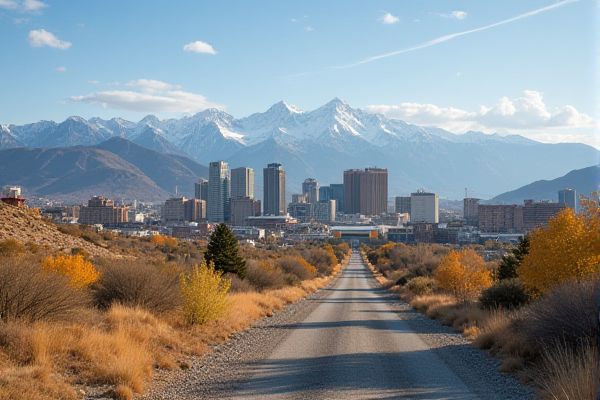
Moving to Utah checklist: Research local laws and regulations. Understand the climate and weather patterns. Explore housing market and costs. Familiarize with Utah's job market. Discover local recreational activities. Identify reliable moving services. Know public transportation options. Register for local utilities and services. Investigate local education systems. Join Utah community groups.
Research local laws and regulations.
When moving to a new city, it's essential to research local laws and regulations to ensure you comply with all necessary requirements. This includes checking into the laws and requirements of your new city regarding home-based businesses, professional tests, business licenses, and any special laws that might pertain to you. If you're considering relocating to Utah, you can find a comprehensive guide on these regulations by visiting the Moving to Utah Checklist. Being informed about these aspects can make your transition smoother and help you avoid any legal issues down the line.
Understand the climate and weather patterns.
Utah has a dry, semi-arid, and desert climate with four distinct seasons. The state experiences extreme temperatures, from record lows to highs, with the most pleasant weather typically occurring between late April to mid-June and late August to mid-October. Winters can be cold with potential inversions affecting air quality, while summers are hot but characterized by a "dry heat" due to low humidity. For more detailed information on planning your trip and understanding the weather patterns, visit the Visit Utah website.
Explore housing market and costs.
When moving to Utah, be prepared for a competitive housing market with median home prices around $600,000 in Salt Lake County and $577,500 in Utah County. This is driven by factors such as limited inventory, a robust job market, and low interest rates, making affordability a significant concern. For those considering relocating, it is essential to explore the New Homes in Daybreak, Utah to better understand the dynamics of this thriving region.
Familiarize with Utah's job market.
Utah's job market is robust, with a current job count of 1,769,700 and a seasonally adjusted unemployment rate of 3.5% as of September 2024. The state has added 32,100 jobs over the past 12 months, with strong sectors including Education and Health Services, Construction, and Manufacturing. Although the labor market has softened slightly in recent months, you can read more about these developments on the Utah Employment Summary. The consistent growth reflects the resilience and adaptability of Utah's economic landscape, providing opportunities and stability for job seekers and businesses alike.
Discover local recreational activities.
Utah Valley offers a wide range of outdoor recreational activities across all seasons, including hiking, hunting, water sports, cycling, paragliding, and climbing, with access to stunning natural landscapes such as rugged trails, serene lakes, and scenic parks. In contrast, Salt Lake provides numerous outdoor recreation opportunities, including hiking and biking in local canyons, skiing and snowboarding at nearby resorts, fishing and wildlife expeditions, river adventures, and golfing, with easy access to national parks and monuments. Meanwhile, South Salt Lake features city and county parks with mountain views, creek access, sports fields, playgrounds, and fitness stations, as well as regional trails like Parley's Trail and the Jordan River Trail, offering biking, hiking, and boating opportunities.
Identify reliable moving services.
For reliable moving services in Utah, consider companies like Best Of Utah Moving Company LLC, Moving Connections, and Wasatch Moving Company. These companies are highly rated for their professionalism, transparent pricing, and comprehensive services, including packing, unpacking, and specialty item handling. For more information and options, you can visit the MoveBuddha website.
Know public transportation options.
In Utah, particularly in the Salt Lake City area, public transportation is efficiently managed by the Utah Transit Authority (UTA), offering a comprehensive network that includes light rail, buses, and commuter trains. The TRAX light rail system features three color-coded lines, seamlessly connecting various parts of the valley, from the airport to downtown. Additionally, buses provide extensive routes not only across the Salt Lake Valley but also to areas beyond, enhancing the mobility options for residents and visitors alike. The FrontRunner commuter trains link major cities from Ogden to Provo, making travel between these destinations straightforward and convenient. Paying for fares is flexible; options include the use of cash, the Transit app, or prepaid fare cards such as FAREPAY. To plan your visit and learn more about these convenient transport options, you can explore the Visit Salt Lake website for detailed information.
Register for local utilities and services.
To register for local utilities and services in Utah, new residents must complete a Utility Service application, provide a valid government-issued ID, and set up an account online or through the utility provider's website. Websites like XpressBillPay for Centerville facilitate this process. Alternatively, residents can contact specific utility companies such as Rocky Mountain Power for electricity and Dominion Energy for natural gas.
Investigate local education systems.
Investigate Utah's local education system by reviewing information on K-12 education, including public, charter, and private schools, as well as resources for higher education, scholarship information, and college admission requirements. The site also provides data on student enrollment, graduation rates, and educational standards set by the Utah State Board of Education.
Join Utah community groups.
Joining Utah community groups through Meetup allows you to connect with locals interested in various activities, such as theater, canyoneering, paddling, and more, helping you integrate into the community and build new relationships.
